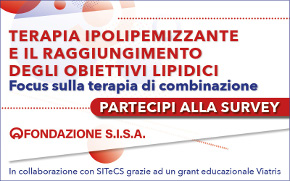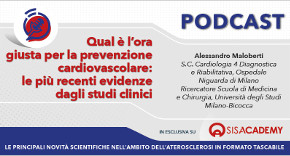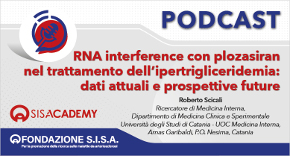 Rivista in lingua italiana
Rivista in lingua italiana
riservata ai Soci SISA
Ultimo numero:
Anno 16 • N.1/2025
SISANews
Ezetimibe, atorvastatina e regressione della placca
La capacità della terapia ipocolesterolemizzante nella prevenzione delle malattie cardiovascolari è ben documentata, ma è altrettanto ben documentato che anche dopo il raggiungimento dei livelli raccomandati di colesterolo LDL, rimane una elevata percentuale di pazienti che va incontro ugualmente a eventi cardiovascolari. E' il rischio residuo, che si cerca di ridurre aumentando l'attenzione sui fattori di rischio controllabili, primo fra tutti il colesterolo. I vari studi che si sono succeduti nel tempo hanno confermato l'ipotesi avanzata alcuni anni fa che tanto più si riduce il colesterolo LDL, tanto più si prevengono gli eventi cardiovascolari. Lo studio giapponese, dà un'ulteriore conferma, seppure indiretta, all'ipotesi. Lo studio è condotto su pazienti coronaropatici, studiati con ultrasonografia intracoronarica (IVUS), trattati con atorvastatina+ezetimibe o con la sola atrovastatina. Con la terapia combinata il colesterolo LDL è sceso ad un livello medio di 63 mg/dL e questo si è associato ad una maggiore regressione della placca rispetto a quanto osservato nel gruppo in monoterapia in cui il colesterolo LDL si era attestato sui 73 mg/dL
![]()
Impact of Dual Lipid-Lowering Strategy With Ezetimibe and Atorvastatin on Coronary Plaque Regression in Patients With Percutaneous Coronary Intervention: The Multicenter Randomized Controlled PRECISE-IVUS Trial
Tsujita K, Sugiyama S, Sumida H, Shimomura H, Yamashita T, Yamanaga K, Komura N, Sakamoto K, Oka H, Nakao K, Nakamura S, Ishihara M, Matsui K, Sakaino N, Nakamura N, Yamamoto N, Koide S, Matsumura T, Fujimoto K, Tsunoda R, Morikami Y, Matsuyama K, Oshima S, Kaikita K, Hokimoto S, Ogawa H; PRECISE-IVUS Investigators
J Am Coll Cardiol. 2015;66:495-507
BACKGROUND: Despite standard statin therapy, a majority of patients retain a high "residual risk" of cardiovascular events.
OBJECTIVES: The aim of this study was to evaluate the effects of ezetimibe plus atorvastatin versus atorvastatin monotherapy on the lipid profile and coronary atherosclerosis in Japanese patients who underwent percutaneous coronary intervention (PCI).
METHODS: This trial was a prospective, randomized, controlled, multicenter study. Eligible patients who underwent PCI were randomly assigned to atorvastatin alone or atorvastatin plus ezetimibe (10 mg) daily. Atorvastatin was uptitrated with a treatment goal of low-density lipoprotein cholesterol (LDL-C) <70 mg/dl. Serial volumetric intravascular ultrasound was performed at baseline and again at 9 to 12 months to quantify the coronary plaque response in 202 patients.
RESULTS: The combination of atorvastatin/ezetimibe resulted in lower levels of LDL-C than atorvastatin monotherapy (63.2 ± 16.3 mg/dl vs. 73.3 ± 20.3 mg/dl; p < 0.001). For the absolute change in percent atheroma volume (PAV), the mean difference between the 2 groups (-1.538%; 95% confidence interval [CI]: -3.079% to 0.003%) did not exceed the pre-defined noninferiority margin of 3%, but the absolute change in PAV did show superiority for the dual lipid-lowering strategy (-1.4%; 95% CI: -3.4% to -0.1% vs. -0.3%; 95% CI: -1.9% to 0.9% with atorvastatin alone; p = 0.001). For PAV, a significantly greater percentage of patients who received atorvastatin/ezetimibe showed coronary plaque regression (78% vs. 58%; p = 0.004). Both strategies had acceptable side effect profiles, with a low incidence of laboratory abnormalities and cardiovascular events.
CONCLUSIONS: Compared with standard statin monotherapy, the combination of statin plus ezetimibe showed greater coronary plaque regression, which might be attributed to cholesterol absorption inhibition-induced aggressive lipid lowering.
J Am Coll Cardiol. 2015;66:495-507

Area Soci
Eventi
39° Congresso Nazionale
 39° Congresso Nazionale
39° Congresso NazionaleRoma, 23-25 novembre 2025
Save the date




 Spring Meeting Gruppi Giovani SID, SIGG, SIIA, SIMI, SIPREC, SISA
Spring Meeting Gruppi Giovani SID, SIGG, SIIA, SIMI, SIPREC, SISARimini, 6-8 aprile 2025
[continua a leggere]
 SISA LIPID ACADEMY - Corso avanzato di lipidologia clinica
SISA LIPID ACADEMY - Corso avanzato di lipidologia clinicaModena, 4-5 Luglio 2024
[continua a leggere]Giornale Italiano Arteriosclerosi
HoFH today
 Rivista Italiana della
Rivista Italiana della
Ipercolesterolemia
Familiare Omozigote
Anno 6 • N.1/2024
Rivista NMCD
Diateca
[continua a leggere]
[continua a leggere]
Newsletter
il vostro indirizzo di posta elettronica
Progetto LIPIGEN

Nuovo sito dedicato al Progetto LIPIGEN
Progetto LIPIGEN - Vecchio portale
E' necessario essere loggati come utente
Lipigen per poter accedere alla pagina
PROject Statin Intolerance SISA
PROSISA – PROject Statin Intolerance SISA
E' necessario essere loggati come utente
PROSISA per poter accedere alla pagina
GILA - Lipoprotein Aferesi
Gruppo Interdisciplinare Lipoprotein Aferesi
(Accesso Gruppo GILA-Lipoprotein Aferesi)
E' necessario essere loggati come utente del Gruppo GILA per poter accedere
Gruppo Interdisciplinare Lipoprotein Aferesi
(Documentazione ad accesso libero)
Pagina informativa per medici e pazienti










